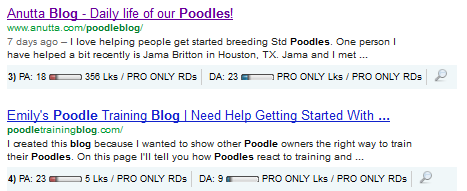What Makes A Good Backlink Prospect? A Framework For Qualifying Prospects For Link‑Building
In SEO, sometimes you need to go out there and directly contact bloggers and webmasters and win links one-by-one. There are 6 steps in direct link building:
- Needs analysis. How much direct link building is needed (if any)? Which pages and keywords need supported?
- Figuring out where to look. Examples: Google searches for blogs in a specific area, a list of your Twitter followers that have websites, competitor link profiles, etc…
- Pulling prospect lists. Examples: performing the Google searches, retrieving Followerwonk data, retrieving Open Site Explorer link data, etc…
- QUALIFYING PROSPECTS
- Pitching. For example, emailing or calling qualified prospects.
- Follow-ups.
This article pertains to #4, qualifying prospects – that is, going through a list of websites and deciding which sites deserve the significant time required to try to obtain a link from them.
It’s one of the most time-consuming steps in the direct link-building process, and many full-time SEOs like myself have spent hundreds of hours of their life checking out thousands of sites. Thus, there is a need to do it as efficiently as possible, without missing quality link targets. Last week, I was scouring hundreds of sites in a Followerwonk download, and I realized 3 things:
- I was sick of doing this, and I wished could get an intern to do it.
- For that to happen, I’d have to figure out a simple, repeatable process that could be easily taught.
- There was indeed a simple framework, and the reason things had gotten so tedious for me that day is that I wasn’t following it.
Here’s the framework:
There’s 3 Link Criteria
- Link Power
- Relevance
- Difficulty
You Need a System
- Identify needs and set qualifiers/disqualifiers
- Use prospecting tools
- Record your findings
Ask 3 Questions
- Should I click on the site? If yes…
- Is the site a link target? If yes…
- How good of a target is it?
Use this 1 Question Shortcut whenever you can
Do we expect the link to pass enough traffic value to be worth our time?
Now let’s dig in.
The 3 link Criteria
Ok, so there are tons of different factors affecting link value. But we can make it simple. There are 3 criteria you can use to determine whether or not a site is worth your time to obtain the link.
1. Link Power
A link’s benefit comes from its traffic and its “juice”. Traffic is pretty straightforward – a powerful link will likely refer a nice number of visits. The “juice” concept gets tricky, though. Factors involved in a link’s juice include:
- Page Authority
- Domain Authority
- # of external links on the page (the less links, the more juice per link)
- Presence/absence of nofollow attribute
- Location on the page (higher is a little better)
- Whether or not the link is html
- Site/page shadiness: if the site is participating in a link scheme or violating Google Webmaster Quality Guidelines, not only will the link have little to no power, but it may also have negative power – that is, a shady link might reduce the power of your entire link profile. So stay away from bad neighborhoods!
2. Relevance
While a link with a lot of power will pass on more traffic and authority to your site, a link with high relevancy gives you quality traffic and helps Google determine if it should rank your highly for certain keywords.
Relevancy is increased when:
- the anchor text of the link matches (or is close to) the destination page’s targeted keywords
- the words near the link match or (or are close to) your page’s targeted keywords
- the words on the page linking to you match or (or are close to) your page’s targeted keywords
- the site linking to you is relevant to your page and site
3. Difficulty
A link that only adds a little bit of value is still worth your time if it’s really easy to get. Conversely, a costly link like contributing a unique 2,000 word case study or sponsoring an organization for $500 is only SEO-justifiable for really good links (but you can always do it out of the kindness of your heart).
A few questions to ask to gauge difficulty are:
- Does the site link out to anyone?
- Is there a stated method to submit a listing?
- Do you have anything you can offer to these people?
- Is there a blog? Does it write about things you can write about?
- Are there guest authors?
- Are there author guidelines? What are they?
Tying the criteria together
Naturally, it’s all about that ROI. Would the relevance and power of the link return more benefit than the time (and maybe money) it costs you? If so, you go for it.
Unfortunately, evaluating all the previously listed factors to determine the value of the benefit from link juice and relevancy can take some time, especially for normal people. That’s why there a real nice shortcut to quickly estimate a potential link’s benefit:
SHORTCUT: Ask ONE question, “DO WE EXPECT THE LINK TO PASS ENOUGH TRAFFIC VALUE TO BE WORTH OUR TIME?
Here’s why I love this “smell test” question:
- Relevant, quality traffic is worth more, and comes from relevant quality pages and sites.
- Sites high in authority usually have more traffic.
- Expert authors usually pass better traffic in outbound links than your average shmoes; they also tend to have pages with high authority.
- A page with 1000 links will likely pass less traffic per outbound link than a page with 1 outgoing link.
- Traffic itself has value.
- Many nofollow links, like a great Tweet or a Wikipedia link, are worth obtaining – evaluating them on traffic will ensure you don’t pass them up.
- Evaluating traffic potential is simple and intuitive.
Thus, if SEO didn’t exist, and you would never waste your time to obtain a link from a potential target for traffic alone, then it probably just isn’t worth your time.
Getting a System Together
Valuing a link can be very time consuming and the value varies from case to case, so you want to establish some shortcuts that work for your specific scenario.
1. Identify needs and set qualifiers/disqualifiers
A worthwhile link prospect for a Boston Poodle breeder is probably not going to be a good backlink prospect for an authoritative Internet marketing site. So, ask yourself some questions before you begin evaluating prospects like:
- How much traffic and authority is worth my while?
- Are there any types of links I just have too much of? (For example, if a previous SEO built 1,000 crappy directory links, you might want to avoid “SEO-friendly directories” and other poor quality link sources.
- What’s my quality threshold?
- What types of sites and pages in this niche are linking out?
- What keywords am I trying to support?
- Is there a type of link I’m really good or bad at (like guest posting, or forum contributions, etc…?)
Once you answer these questions, you can set up mental STOP Signals and GO Signals to speed things up:
Examples of STOP Signals might include:
- “SEO friendly directory”
- “link partners”
- “Hot dog” or other irrelevant words
- Horrible content
- Page rank = 0
Examples of GO Signals might include:
- “guest post”
- “poodle” or other super relevant keywords
- Lots of twitter or Facebook shares (indicates high engagement and traffic)
- Moderate outbound linking
And remember – the simplest, most efficient prospect qualifier is to ask yourself, “Does the link from this source add worthwhile value solely from the traffic it passes?”
2. Use prospecting tools
So now that you know what you’re looking for, you need some tools to find it fast. You definitely want a tool to gauge traffic, and it’s best if it is a browser toolbar. Page and domain authority metrics can be helpful if you want more to look at.
Below is a free toolbar from SEO Book, combined with a free toolbar from SEOmoz:

Also helpful are highlighters. I like to be able to highlight nofollow links and external links as well as specific words. The SEOmoz toolbar has this function.
Any tool that can give you site and page data before you have to even click on a site is especially valuable. For example, I recently found out about Outreachr’s free tool to show link juice metrics of a list of domains. Also, the SEOmoz toolbargets yet another mention, for showing authority metrics on search results pages:

3. Record findings
So you’ve found a site you’d like to get a link from, now what? Well, what I do is record the pertinent data and move on. Nice data might include:
- Rating: You definitely want to rate the prospect so you know if it deserves to be at the top of the list or not.
- Website type: is it a blog, directory, what?
- Link type: should the site be added to the media list for press releases? Should it be on the article contribution outreach list?
- Anything useful you found out that you don’t want to look for again. This might include: contact emails, ideal page, Twitter handle, link ideas, etc…
There are some CRM-like tools that help you record this data quickly and in an organized way. I’ve had good experiences with Raven Tools and BuzzStream. A spreadsheet might do the trick too.
The 3 Questions to ask during prospecting
So now that you have a plan, some tools, and established backlink prospect evaluation criteria, you’re ready to pour through some prospects.
There are 3 simple steps to do this, and you’re going to evaluate your criteria at each step. Again, in order to evaluate the 3 link factors, you’re going to use STOP signals and GO signals, qualifiers and disqualifiers, to help you determine, “How much value can be added from the traffic a link would pass?”
The idea is to save time by proceeding to the final step only when necessary.
1. Should I click on the site?
Clicking on every site in a list takes up time. This is what was slowing me down so much when I was scouring over the Followerwonk export. Once I realized that, I did 2 things. First, I figured out my stop signals and go signals. Second, I plugged in the prospective sites into Outreachr to gauge authority. Then, I was able to rule out the majority of my list without having to leave my spreadsheet.
2. Is the site a link target?
So once you’ve decided the site is worth your click, you want to decide if it’s a link target or not. You’re just looking for a simple yes or no. The ability to quickly apply a pass/fail will save you a lot of cumulative time.
3. What type of a target is it?
So if the site passes the smell test, it’s time to rate and evaluate the link prospect, and record your findings as we discussed above for things like priority level, website type, link type, contact info, etc… Having that data together in an organized way will better prepare you to fast-pitch to those link targets and win some links.
##
I’m hoping this framework for evaluating backlink prospects can help some people build dozens more links in dozens less hours as well as result in a few less unnecessary outreach e-mails. It’s my first time putting this methodology to paper, so please let me know if you have questions or do things differently!


